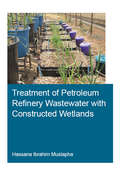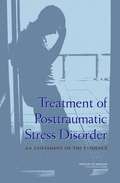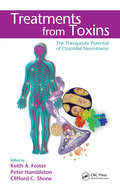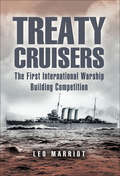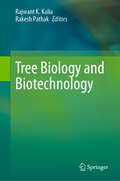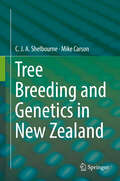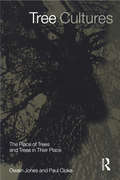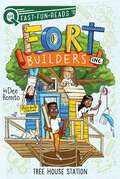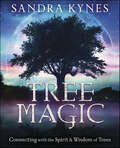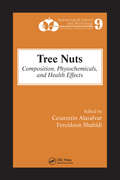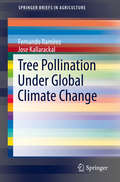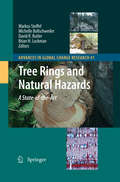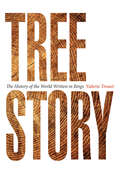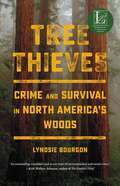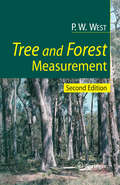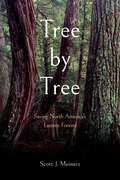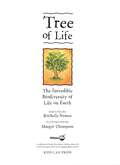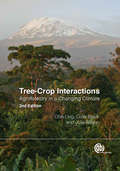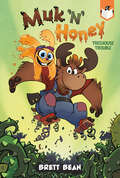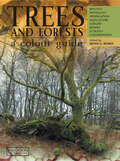- Table View
- List View
Treatment of Petroleum Refinery Wastewater with Constructed Wetlands (IHE Delft PhD Thesis Series)
by Hassana Ibrahim MustaphaPollution of waterbodies and the environment by petroleum industry is of particular concern in Nigeria. This problem can be addressed by the application of constructed wetlands (CWs) which is a nature-based system that is simple to construct, have low operational and maintenance costs in terms of supply of energy and its periodic maintenance. The application of CWs in Nigeria for polishing of petroleum refinery wastewater is an unprecedented research. This PhD thesis focused on some specific objectives which were characterization of treated secondary refinery wastewater, design, construction, operation and monitoring of planted (T. latifolia, C. alternifolius and C. dactylon) and unplanted vertical subsurface flow, horizontal subsurface flow and hybrid CWs for the removal of suspended solids, nutrients, heavy metals, organic matter and organic pollutants. The CWs effectively treated the petroleum contaminated wastewater to effluent compliance limits. In this study, T. latifolia planted CWs had consistently higher removal efficiencies for all the measured parameters than C. alternifolius and C. dactylon planted CW systems. Therefore, in order to improve the wastewater quality discharged by Kaduna Refining and Petrochemical Company (KRPC) Nigeria, meet stringent guidelines and protect the recipient streams, installation of CWs at the effluent discharge point of KRPC is strongly recommended.
Treatment of Post-traumatic Stress Disorder: An Assessment of the Evidence
by Institute of Medicine Committee on Treatment of Posttraumatic Stress Disorder StaffMental disorders, including posttraumatic stress disorder (PTSD), constitute an important health care need of veterans, especially those recently separated from service. Treatment of Posttraumatic Stress Disorder: An Assessment of the Evidence takes a systematic look the efficacy of pharmacologic and psychological treatment modalities for PTSD on behalf of the Department of Veterans Affairs. By reviewing existing studies in order to draw conclusions about the strength of evidence on several types of treatment, the Committee on the Treatment of Posttraumatic Stress Disorder found that many of these studies were faulty in design and performance, and that relatively few of these studies have been conducted in populations of veterans, despite suggestions that civilian and veteran populations respond differently to various types of treatment. The committee also notes that the evidence is scarce on the acceptability, efficacy, or generalizability of treatment in ethnic and cultural minorities, as few studies stratified results by ethnic background. Despite challenges in the consistency, quality, and depth of research, the committee found the evidence sufficient to conclude the efficacy of exposure therapies in treating PTSD. The committee found the evidence inadequate to determine efficacy of different types of pharmacotherapies, of three different psychotherapy modalities, and of psychotherapy delivered in group formats. The committee also made eight critical recommendations, some in response to the VA's questions related to recovery and the length and timing of PTSD treatment, and others addressing research methodology, gaps in evidence and funding issues.
Treatments from Toxins: The Therapeutic Potential of Clostridial Neurotoxins
by Keith A. Foster Peter Hambleton Clifford C. ShoneAs little as two decades ago, deliberately injecting botulinum toxin into patients would have seemed foolhardy at best and criminal at worst. The increased clinical use of botulinum toxins has expanded the body of knowledge available on the structure and function of these proteins. This knowledge can be applied to topics as varied as therapies base
Treaty Cruisers: The First International Warship Building Competition
by Leo Marriott&“A quite enlightening book that discusses the most important group of heavy cruisers serving during WW2 and how the type evolved.&” —Malcolm Wright, author of British and Commonwealth Warship Camouflage of WWII The Washington Naval Treaty of 1921 and subsequent treaties in the 1930s effectively established the size and composition of the various navies in World War II. In particular, they laid down design parameters and tonnage limitations for each class of warship, including battleships, aircraft carriers, cruisers, and destroyers. With one or two exceptions, battleship construction was deferred until the mid 1930s, but virtually all navies embraced the concept of the eight-inch gun-armed, 10,000-ton heavy cruisers and constructed new vessels almost immediately. This book will trace the political processes which led to the treaties, describe the heavy cruisers designed and built to the same rules by each nation, and then consider how the various classes fared in World War II and attempt to assess which was the most successful. Ships from the navies of Britain, France, Italy, Germany, the United States, and Japan are included. Appendices cover construction tables, the history of each ship, technical specifications, armament, and aircraft carried. &“The author has crafted a book that is both a technical read and popular history. The book provides an excellent overview of the reasoning each country employed in building its interwar cruiser force and how they committed these ships to battle. If development of and employment of weapon systems is of interest to you, this is a must-read book.&” —Naval Historical Foundation
Tree Biology and Biotechnology
by Rakesh Pathak Rajwant K. KaliaThis edited book aims to bring out a comprehensive collection of information on tree biology, breeding, improvement, genetics, and biotechnology. The focus of this book is to address the status of tree biology research through biotechnological, physiological, pathological, and entomological aspects. Trees are dominant and perennial species found in several ecosystems. They are the only piece of infrastructure that gains value over time. Their economic relevance is well known in terms of the production of food, feed, fodder, fuel, timber, and other products. Trees are well-known habitats for different organisms. They also deliver various ecosystem services, including temperature regulation, mitigation of soil erosion, and managing and filtering rainwater. Tree species are versatile and are capable of providing livelihood security to people, besides several other advantages. In the era of high population growth and increasing pressure on agricultural systems, efficient management of tree resources is the need of the time. Therefore, it is essential to understand tree biology, breeding, and improvement. This book comprises information on various aspects of tree breeding, biology, genetics, and research in the improvement of tree species. Applications of tissue culture, biotechnological approaches, tree health management, insect pest management, and nutrient recycling have been covered in the book, along with some chapters on case studies from Rajasthan and Africa. This book is a useful read for agricultural students, researchers, teachers, and professionals interested in the fields of agroforestry, horticulture, silviculture, and tree improvement.
Tree Breeding and Genetics in New Zealand
by Mike Carson C.J.A. ShelbourneDothistroma pini changed New Zealand commercial forestry dramatically. Tree breeding became concentrated on a very few species and development of selection methods and breeding strategies changed in response to the new challenges. Tree-Breeding and Genetics in New Zealand provides a critical historical account of the work on provenance research and tree breeding, often with the wisdom of hindsight, and it tracks the development of breeding strategy, especially for P. radiata, Douglas-fir and the most important eucalypt species, E. regnans, E. fastigata and E. nitens. The book is a compendium of abstracts and summaries of all publications and reports on tree improvement in New Zealand since the early 1950s, with added critical comment by the author on much of the work. It is intended for other tree breeders internationally, for interested NZ foresters and for graduate students studying genetics and tree breeding.
Tree Cultures: The Place of Trees and Trees in Their Place
by Paul Cloke Owain JonesThe relationship between nature and culture has become a popular focus in social science, but there have been few grounded accounts of trees. Providing shelter, fuel, food and tools, trees have played a vital role in human life from the earliest times, but their role in symbolic expression has been largely overlooked. For example, trees are often used to express nationalistic feelings. Germans drew heavily on tree and forest imagery in nation-building, and the idea of 'hearts of oak' has been central to concepts of English identity. Classic scenes of ghoulish trees coming to life and forests closing in on unsuspecting passers-by commonly feature in the media. In other instances, trees are used to represent paradisical landscapes and symbolize the ideologies of conservation and concern for nature. Offering new theoretical ideas, this book looks at trees as agents that co-constitute places and cultures in relationship with human agency. What happens when trees connect with human labour, technology, retail and consumption systems? What are the ethical dimensions of these connections? The authors discuss how trees can affect and even define notions of place, and the ways that particular places are recognized culturally. Working trees, companion trees, wild trees and collected or conserved trees are considered in relation to the dynamic politics of conservation and development that affect the values given to trees in the contemporary world. Building on the growing field of landscape study, this book offers rich insights into the symbolic and practical roles of trees. It will be vital reading for anyone interested in the anthropology of landscape, forestry, conservation and development, and for those concerned with the social science of nature.
Tree House Station: A QUIX Book (Fort Builders Inc. #4)
by Dee RomitoThe kids of Fort Builders, Inc., hunt for the perfect treehouse tree in the fourth story in the fun-to-read Aladdin QUIX chapter book series that&’s perfect for emerging readers!Caleb and the rest of the Fort Builders, Inc. group feel like it&’s finally time to have their own dedicated workspace! Their big idea? A fort treehouse! But finding the perfect tree for their unique fort is a little tougher than they thought...
Tree Magic: Connecting with the Spirit & Wisdom of Trees
by Sandra Kynes60+ Trees to Deepen Your Connection with NatureTrees provide a gateway into a wider world of spirit and magic. This book helps you explore their timeless mysteries and work with their unique energy. Popular author Sandra Kynes shows you how to connect with the wonder of the forest and develop a deeper understanding and relationship with trees.This practical guide introduces you to more than sixty varieties of trees, providing illustrations, lore, botanical and historical information, ritual and magical uses, associated deities, and more. Sandra offers an abundance of resources, including correspondence charts, tree and rune calendars, and the Celtic ogham. Learn about tools from the woods like staffs, wands, and wreaths. Discover what items you can use to connect to a particular tree when it's not available in your area. Whether you're looking for a tree aligned with Venus or one to aid your divination, Tree Magic is the ideal resource to bring the magic, spirit, and wisdom of trees into your life.
Tree Nuts: Composition, Phytochemicals, and Health Effects (Nutraceutical Science and Technology)
by Fereidoon Shahidi Cesarettin AlasalvarNuts have been long perceived as a high-fat, high-calorie food, best avoided or consumed in moderation. However, research is showing that tree nuts are cholesterol-free and contain unsaturated fats which can help lower the risk of heart disease. Nuts also provide essential nutrients such as magnesium, chromium, zinc, and manganese. Like all plant foods they are high in fiber and phytochemicals. This book examines ten popular tree nuts and describes each nut's compositional characteristics, lipid characteristics, effects of consumption on serum lipid profiles, as well as their phytochemicals and role disease prevention. In addition the book covers allergens and uses for non-edible parts.
Tree Plantation Extractivism in Chile: Territories, Fundamental Human Needs, and Resistance (Routledge Studies of the Extractive Industries and Sustainable Development)
by Alejandro Mora-MottaThis book examines how extractivism transforms territories and affects the well-being of rural people, drawing on in-depth fieldwork conducted on tree plantations in Chile.The book argues that pine and eucalyptus monoculture plantations in southern Chile are a form of extractivism representing a mode of nature appropriation that captures large amounts of natural resources to produce wooden-based raw materials with little processing and an export-oriented focus. The book discusses the nexus of extractivism, territorial transformations, well-being, and emerging resistances using a participatory action research methodological approach in the Region of Los Ríos, southern Chile. The findings show how the configuration of an extractivist logging enclave generated a substantial and irrevocable reordering of human-nature relations, resulting in the territorial and ontological occupation of rural places that disrupted the fundamental human needs of peasants and indigenous people. The book maintains that Chile's green growth development approach does not challenge the consolidated tree plantation enclave controlled by large multinationals. Instead, green growth legitimises the extractivist logic. The book draws parallels with other countries and regions to contribute to wider debates surrounding these topics.This book will be of great interest to students and scholars of the extractive industries, development studies, political ecology, and natural resource governance.
Tree Pollination Under Global Climate Change (SpringerBriefs in Agriculture)
by Fernando Ramírez Jose KallarackalThis brief reviews the pollination aspects of both wild and domesticated fruit tree species in a global climate change context. It explores cross-pollination mediated by insects, vertebrates and abiotic factors, self-pollination and their global warming implications. The authors identify the link between abiotic factors such as precipitation and severe droughts in the context of tree pollination and climate change. Furthermore, pollination and conservation implications in agriculture as well as wild tree populations are explored. Emphasis has been given to fruit trees growing in tropical, subtropical and temperate environments.
Tree Rings and Natural Hazards
by David R. Butler Brian H. Luckman Markus Stoffel Michelle BollschweilerThe initial employment of tree rings in natural hazard studies was simply as a dating tool and rarely exploited other environmental information and records of damage contained within the tree. However, these unique, annually resolved, tree-ring records preserve valuable archives of past earth-surface processes on timescales of decades to centuries. As many of these processes are significant natural hazards, understanding their distribution, timing and controls provides valuable information that can assist in the prediction, mitigation and defence against these hazards and their effects on society. Tree Rings and Natural Hazards provides many illustrations of these themes, demonstrating the application of tree rings to studies of snow avalanches, rockfalls, landslides, floods, earthquakes, wildfires and several other processes. Several of the chapters are "classic studies", others represent recent applications using previously unpublished material. They illustrate the breadth and diverse applications of contemporary dendrogeomorphology and underline the growing potential to expand such studies, possibly leading to the establishment of a range of techniques and approaches that may become standard practice in the analysis of natural hazards in the future.
Tree Story: The History of the World Written in Rings
by Valerie TrouetWhat if the stories of trees and people are more closely linked than we ever imagined?Winner of the World Wildlife Fund's 2020 Jan Wolkers PrizeOne of Science News's "Favorite Books of 2020" A New York Times "New and Noteworthy" BookA 2020 Woodland Book of the YearGold Winner of the 2020 Foreword INDIES Award in Ecology & EnvironmentBronze Winner of the 2021 Independent Publisher Book Award in Environment/EcologyPeople across the world know that to tell how old a tree is, you count its rings. Few people, however, know that research into tree rings has also made amazing contributions to our understanding of Earth's climate history and its influences on human civilization over the past 2,000 years. In her captivating book Tree Story, Valerie Trouet reveals how the seemingly simple and relatively familiar concept of counting tree rings has inspired far-reaching scientific breakthroughs that illuminate the complex interactions between nature and people.Trouet, a leading tree-ring scientist, takes us out into the field, from remote African villages to radioactive Russian forests, offering readers an insider's look at tree-ring research, a discipline known as dendrochronology. Tracing her own professional journey while exploring dendrochronology's history and applications, Trouet describes the basics of how tell-tale tree cores are collected and dated with ring-by-ring precision, explaining the unexpected and momentous insights we've gained from the resulting samples.Blending popular science, travelogue, and cultural history, Tree Story highlights exciting findings of tree-ring research, including the fate of lost pirate treasure, successful strategies for surviving California wildfire, the secret to Genghis Khan's victories, the connection between Egyptian pharaohs and volcanoes, and even the role of olives in the fall of Rome. These fascinating tales are deftly woven together to show us how dendrochronology sheds light on global climate dynamics and uncovers the clear links between humans and our leafy neighbors. Trouet delights us with her dedication to the tangible appeal of studying trees, a discipline that has taken her to austere and beautiful landscapes around the globe and has enabled scientists to solve long-pondered mysteries of Earth and its human inhabitants.
Tree Thieves: Crime and Survival in North America's Woods
by Lyndsie BourgonSHORTLISTED FOR THE COLUMBIA SCHOOL OF JOURNALISM J. ANTHONY LUKAS BOOK AWARD LONGLISTED FOR THE 2023 PEN/JOHN KENNETH GALBRAITH AWARD FOR NONFICTION FINALIST FOR THE NELLIE BY CHANTICLEER INTERNATIONAL BOOK AWARDS FOR JOURNALISTIC NON-FICTION A gripping investigation of the billion-dollar timber black market &“and a fascinating examination of the deep and troubled relationship between people and forests&” (Michelle Nijhuis, author of Beloved Beasts). There's a strong chance that chair you are sitting on was made from stolen lumber. In Tree Thieves, Lyndsie Bourgon takes us deep into the underbelly of the illegal timber market. As she traces three timber poaching cases, she introduces us to tree poachers, law enforcement, forensic wood specialists, the enigmatic residents of former logging communities, environmental activists, international timber cartels, and indigenous communities along the way. Old-growth trees are invaluable and irreplaceable for both humans and wildlife, and are the oldest living things on earth. But the morality of tree poaching is not as simple as we might think: stealing trees is a form of deeply rooted protest, and a side effect of environmental preservation and protection that doesn't include communities that have been uprooted or marginalized when park boundaries are drawn. As Bourgon discovers, failing to include working class and rural communities in the preservation of these awe-inducing ecosystems can lead to catastrophic results. Featuring excellent investigative reporting, fascinating characters, logging history, political analysis, and cutting-edge tree science, Tree Thieves takes readers on a thrilling journey into the intrigue, crime, and incredible complexity sheltered under the forest canopy.
Tree and Forest Measurement
by Phil WestForests must be measured, if they are to be managed and conserved properly. This book describes the principles of modern forest measurement, whether using simple, hand-held equipment or sophisticated satellite imagery. Written in a straightforward style, it will be understood by everyone who works with forests, from the professional forester to the layperson. It describes how and why forests are measured and the basis of the science behind the measurements taken.
Tree by Tree: Saving North America's Eastern Forests
by Scott J. MeinersTree by Tree is a warning and a toolkit for the future of forest recovery. Scott J. Meiners investigates the critical biological threats endangering tree species native to the forests of eastern North America, providing a needed focus on this plight. Meiners suggests that if we are to save our forests, the first step is to recognize the threats in front of us. Meiners focuses on five familiar trees—the American elm, the American chestnut, the eastern hemlock, the white ash, and the sugar maple—and shares why they matter economically, ecologically, and culturally. From outbreaks of Dutch elm disease to infestations of emerald ash borers, Meiners highlights the challenges that have led or will lead to the disappearance of these trees from forests. In doing so, he shows us how diversity loss often disrupts intricately balanced ecosystems and how vital it is that we pay more attention to massive changes in forest composition.With practical steps for the conservation of native tree species, Tree by Tree offers the inspiration and insights we need to begin saving our forests.
Tree of Life: The Incredible Biodiversity Of Life On Earth (Citizenkid Ser.)
by Rochelle StraussIf every known species on Earth were a leaf on a tree, that tree would have 1 750 000 leaves. Since humans count for just one leaf on the tree, we have a lot to learn about the millions of other forms of life with which we share the world. A dazzlingly illustrated and child-friendly introduction to biodiversity, Tree of Life shows how living things are classified into five kingdoms - and how each has much to tell us about all aspects of life on our planet. Tree of Life is part of Citizen Kid: A collection of books that inform children about the world and inspire them to be better global citizens.
Tree of Origin: What Primate Behavior Can Tell Us about Human Social Evolution
by F. B. WaalHow did we become the linguistic, cultured, and hugely successful apes that we are? Our closest relatives--the other mentally complex and socially skilled primates--offer tantalizing clues. In Tree of Origin nine of the world's top primate experts read these clues and compose the most extensive picture to date of what the behavior of monkeys and apes can tell us about our own evolution as a species. It has been nearly fifteen years since a single volume addressed the issue of human evolution from a primate perspective, and in that time we have witnessed explosive growth in research on the subject. Tree of Origin gives us the latest news about bonobos, the "make love not war" apes who behave so dramatically unlike chimpanzees. We learn about the tool traditions and social customs that set each ape community apart. We see how DNA analysis is revolutionizing our understanding of paternity, intergroup migration, and reproductive success. And we confront intriguing discoveries about primate hunting behavior, politics, cognition, diet, and the evolution of language and intelligence that challenge claims of human uniqueness in new and subtle ways. Tree of Origin provides the clearest glimpse yet of the apelike ancestor who left the forest and began the long journey toward modern humanity.
Tree-Crop Interactions: Agroforestry in a Changing Climate
by Dennis DennisThis new edition provides an update on the considerable amount of evidence on tree-crop interactions which has accumulated during the last two decades, especially on the more complex multi-strata agroforestry systems, which are typical of the humid tropics. In addition three new chapters have been added to describe the new advances in the relationship between climate change adaptation, rural development and how trees and agroforestry will contribute to a likely reduction in vulnerability to climate change in developing countries
Treehouse Trouble #1 (Muk 'n' Honey)
by Brett BeanMeet Honey Bunny and Muk Muk Moose: the inventor duo who make whimsical creations to help the forest, even if it takes them a few times to get it right! Designed to engage early readers, this chapter book series combines simple text, lively illustrations, and laugh-out-loud humor to help boost kids' confidence and create lifelong readers!Honey Bunny and Muk Muk Moose may be forest inventors, but when the staircase to their treehouse collapses, they're stumped! Not only do they have to get back up in time to take their delicious Triple Decker Hunger Wrecker concoction out of the oven, but now some of their friends need help solving their own problems, too. Can Honey Bunny and Muk Muk Moose come up with new creations to help everyone, even themselves?With full-color illustrations on every spread, this humorous and whimsical story is perfect for kids just beginning to read on their own. The short chapters, early vocabulary, and amusing illustrations make reading easy and fun! Exciting, easy-to-read books are the stepping stone a young reader needs to bridge the gap between being a beginner and being fluent.
Treekeepers: The Race for a Forested Future
by Lauren E. Oakes&“A frank, probing, but ultimately hopeful book&” (Elizabeth Kolbert) that shows how the path from climate change to a habitable future winds through the world&’s forests In recent years, planting a tree has become a catchall to represent &“doing something good for the planet.&” Many companies commit to planting a tree with every purchase. But who plants those trees and where? Will they flourish and offer the benefits that people expect? Can all the individual efforts around the world help remedy the ever-looming climate crisis? In Treekeepers, Lauren E. Oakes takes us on a poetic and practical journey from the Scottish Highlands to the Panamanian jungle to meet the scientists, innovators, and local citizens who each offer part of the answer. Their work isn&’t just about planting lots of trees, but also about understanding what it takes to grow or regrow a forest and to protect what remains. Throughout, Oakes shows the complex roles of forests in the fight against climate change, and of the people who are giving trees a chance with hope for our mutual survival. Timely, meticulously reported, and ultimately optimistic, Treekeepers teaches us how to live with a sense of urgency in our warming world, to find beauty in the present for ourselves and our children, and to take action big or small.
Trees & Forests, A Colour Guide: Biology, Pathology, Propagation, Silviculture, Surgery, Biomes, Ecology, and Conservation
by Bryan G. BowesTrees are one of the dominant features of our existence on earth and play a fundamental role in the environment. This book gives the reader an overview and understanding of trees. Subject areas covered include ecology and conservation, tree anatomy and evolution, pathology, silviculture, propagation, and surgery. The different chapters cover trees
Trees and Forests of Tropical Asia: Exploring Tapovan
by David Lee Peter AshtonInformed by decades of researching tropical Asian forests, a comprehensive, up-to-date, and beautifully illustrated synthesis of the natural history of this unique place. Trees and Forests of Tropical Asia invites readers on an expedition into the leafy, humid, forested landscapes of tropical Asia—the so-called tapovan, a Sanskrit word for the forest where knowledge is attained through tapasya, or inner struggle. Peter Ashton and David Lee, two of the world’s leading scholars on Asian tropical rain forests, reveal the geology and climate that have produced these unique forests, the diversity of species that inhabit them, the means by which rain forest tree species evolve to achieve unique ecological space, and the role of humans in modifying the landscapes over centuries. Following Peter Ashton’s extensive On the Forests of Tropical Asia, the first book to describe the forests of the entire tropical Asian region from India east to New Guinea, this new book provides a more condensed and updated overview of tropical Asian forests written accessibly for students as well as tropical forest biologists, ecologists, and conservation biologists.
Trees in a Changing Environment
by Michael Tausz Nancy GrulkeThis book delivers current state-of-the-science knowledge of tree ecophysiology, with particular emphasis on adaptation to a novel future physical and chemical environment. Unlike the focus of most books on the topic, this considers air chemistry changes (O3, NOx, and N deposition) in addition to elevated CO2 effects and its secondary effects of elevated temperature. The authors have addressed two systems essential for plant life: water handling capacity from the perspective of water transport; the coupling of xylem and phloem water potential and flow; water and nutrition uptake via likely changes in mycorrhizal relationships; control of water loss via stomata and its retention via cellular regulation; and within plant carbon dynamics from the perspective of environmental limitations to growth, allocation to defences, and changes in partitioning to respiration. The authors offer expert knowledge and insight to develop likely outcomes within the context of many unknowns. We offer this comprehensive analysis of tree responses and their capacity to respond to environmental changes to provide a better insight in understanding likelihood for survival, as well as planning for the future with long-lived, stationary organisms adapted to the past: trees.
